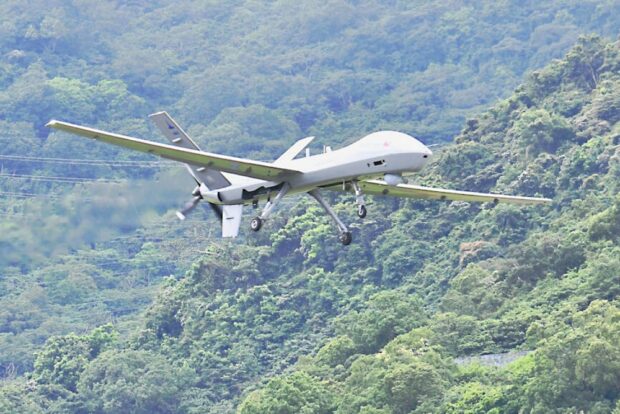Taiwan reached another defense milestone after the domestically developed Teng Yun 2 drone stayed airborne for more than 20 hours during its most recent test flight.
The drone broke its first record in June last year when it flew for 10 hours straight, following the entire perimeter of Taiwan’s air defense identification zone.
The new 20-hour record means that the drone could be used to monitor the Taiwan Strait for nearly an entire day at a time, the source said.
Designed by the Chungshan Institute of Science and Technology, the Teng Yun 2, or “Cloud Rider 2” (騰雲二型), can operate day and night in all weather conditions, and is capable of aerial image surveillance and reconnaissance, electronic parameter reconnaissance, electronic interference, meteorological observation and relaying signals.
The Teng Yun 2 is a large, long-endurance, satellite-guided, medium-altitude drone that can carry multiple payloads, meaning that it can be used for surveillance or strike missions, information from the institute showed.
It can also take off and land autonomously, and has multiple guidance and control links, as well as ground-networked communication links.
“During a combat scenario, the drone could provide remote, real-time surveillance information, and could play an important early warning role,” the source said.
The Teng Yun 2 is expected to be used by the military alongside US-made MQ-9 Reaper drones, with the Reapers being responsible for high-altitude surveillance and reconnaissance missions, and the Teng Yun 2 to be used for medium and low-altitude missions, the source said.
The drone’s capabilities would give the military more flexible and robust surveillance capabilities, they said.
“However, the number of drones that the air force will purchase is still undetermined, and that would affect how they are deployed,” the source said.
The Chinese military is also developing drones, which it hopes will strengthen its surveillance and reconnaissance capabilities, so Taiwan’s military must simultaneously surveil at different altitudes to give it an advantage, the source said.
In other military news, the Ministry of National Defense said that over the past 24 hours it had detected eight Chinese fighter jets crossing the median line of the Taiwan Strait, as well as one Chinese balloon.
The ministry said the Chinese J-10, J-11 and J-16 fighter jets had crossed the median line to the north and center of the Strait.
The median line once served as an unofficial barrier between the two sides, but Chinese planes now regularly fly over it. Taiwan sent its own forces to monitor the fighter jets, the ministry said.
The ministry also reported another Chinese balloon in the Strait.
Taipei officials have said the balloons are most likely for monitoring the weather, and the spate of sightings could be due to the direction of winds.
The balloon was spotted after crossing the median line late on Saturday morning, 97 nautical miles (180km) northwest of Keelung at an altitude of approximately 6,100m, the ministry said, adding that it headed east and disappeared about an hour later.
The potential for China to use balloons for spying became a global issue in February when the US shot down what it said was a Chinese surveillance balloon. China said the balloon was a civilian craft that had accidentally drifted into the US.
Sources: Taipei Times; YouTube

